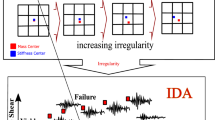Abstract
Present study is focused on seismic performance of torsion irregular building by probabilistic approach. Incremental dynamic analysis-based fragility curves are developed to cover various uncertainties involved in performance evaluation. Among different methods, regression analysis has been used to estimate fragility curve parameters. Torsion imbalanced building model from SMART 2008 project has been studied. Seismic performance is investigated by developing fragility curves for various damage states along global orthogonal directions. To see the damages at local level, fragility curves are also been developed for specified control points. From the study it has been observed that, for torsion imbalance buildings, shear wall is very effective in reducing the probability of damage, in distributing similar effect along orthogonal directions. It is also been observed that probability of damage at non-orthogonal corners is relatively significant than orthogonal corners.












Similar content being viewed by others
References
A. Aziminejad, A. Moghadam, Performance of asymmetric multistory shear buildings with different strength distributions. Journal of Applied Science 9(6), 1080–1089 (2009)
A Vesile and P Gulkan (2012), Fragility of shear wall buildings with torsional irregularities. 15 WCEE Lisbo.
C. Gulec, A. Whittaker, J. Hooper, Fragility functions for low aspect ratio reinforced concrete walls. Eng. Struct. 32, 2894–2901 (2010)
D. Vamvatsikos, C. Cornell, Incremental dynamic analysis. Earthq. Eng. Struct. Dyn. 31(3), 491–514 (2002)
E. Erduran, A. Yakut, Vulnerability assessment of reinforced concrete moment resisting frame buildings. J. Struct. Eng. Am. Soc. Civil Eng. (ASCE) 133(4), 576–586 (2007)
F Jalayer and C Cornell (2003) A technical framework for probability-based demand and capacity factor design (DCFD) seismic formats. Pacific Earthquake Engineering Research Center PEER Rep. 2003/8, PEER Berkeley, California
FEMA P-695, Quantification of Building Seismic Performance Factors (Federal Emergency Management Agency, Washington, 2009).
FEMA-356, Pre-Standard and Commentary for the Seismic Rehabilitation of Buildings (Federal Emergency Management Agency, Washington, 2000).
I. Mehmet, H. Ozmen, Effects of plastic hinge properties in non-linear analysis of reinforced concrete buildings. Eng. Struct. 28(2006), 1494–1502 (2006)
IS1893 Part 1, Indian Standard—“Criteria for Earthquake Resistant Design of Structures”, Part 1: General Provisions and Buildings (5th Revision) (Bureau of Indian Standards, New Delhi, 2016).
O. Cengiz, I. Ali, Commonly encountered seismic design faults due to the architectural design of residential buildings in Turkey. Build. Environ. 42(2007), 1406–1416 (2007)
R. Gianvittorio, T. Immacolata, Seismic assessment of existing RC frames: Probabilistic approach. J. Struct. Eng. ASCE 135(7), 836–852 (2009)
A. Seong-HoonJeonga, Fragility relationships for torsionally-imbalanced buildings using three-dimensional damage characterization’. Eng. Struct. 29(2007), 2172–2182 (2006)
SNA Saruddina and FM Nazria (2015), "Fragility curves for low- and mid-rise buildings in Malaysia", The 5th International Conference of Euro Asia civil engineering forum (EACEF-5), Procedia Engineering 125 (2015) 873–878
V. Patil, S. Tande, Development of seismic fragility curves for mid-rise masonry infilled reinforced concrete building by incremental dynamic analysis’. J. Struct. Eng 44(4), 297–306 (2017)
V. Patil, S. Tande, Probabilistic seismic performance assessment of brick masonry infill reinforced concrete building’. Int. J. Adv. Struct. Eng. (2018). https://doi.org/10.1007/s40091-018-0196-y
V. Patil, S. Tande, Probabilistic versus deterministic method of seismic performance evaluation’. Asian J. Civil Eng. (2018). https://doi.org/10.1007/s42107-018-0015-6
Y Wen, B Ellingwood, J Bracci (2004) “Vulnerability function framework for consequence-based engineering”, Vol. DS-4, MAE Center Project DS-4 Report.
ZW Miao, XZ Lu, JJ Jiang, and LP Ye LP (2006). Non-linear FE Model for RC Shear Walls Based on Multi-layer Shell Element and Micro plane Constitutive Model. Computational Methods in Engineering And Science EPMESC X, 21-23,
Author information
Authors and Affiliations
Corresponding author
Ethics declarations
Conflict of interest
The authors declared that they have no conflict of interest.
Additional information
Publisher's Note
Springer Nature remains neutral with regard to jurisdictional claims in published maps and institutional affiliations.
Rights and permissions
About this article
Cite this article
Shamrao, P.V. Seismic Fragility Analysis for Torsionally Imbalanced Shear Wall Concrete Building. J. Inst. Eng. India Ser. A 102, 553–563 (2021). https://doi.org/10.1007/s40030-021-00527-y
Received:
Accepted:
Published:
Issue Date:
DOI: https://doi.org/10.1007/s40030-021-00527-y




